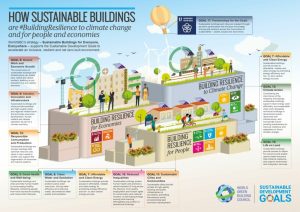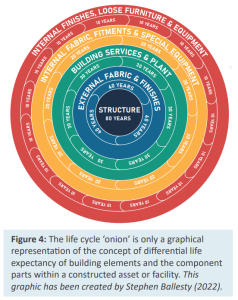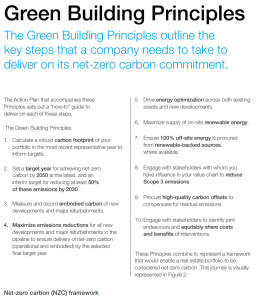You can find additional resources and guides in the
Climate Justice and Resilience Energy Tool
Climate Justice and Resilience Water Tool
1. Why are sustainable and resilient buildings a climate justice matter?
Sustainable and resilient buildings are a key issue for climate justice because they directly affect those who suffer the most from climate change. Poorly built homes and infrastructure often leave marginalised communities more vulnerable to extreme weather events, like floods, bushfires or heatwaves, which are becoming more common due to climate change. By prioritising sustainable building practices, we can ensure that everyone, especially disadvantaged groups, has access to safe, energy-efficient, and climate-resilient homes. This helps reduce energy costs, improve health, and protect lives, making it an essential part of addressing both environmental and social inequalities.
2. Advocacy
Action in this space includes engaging in internal and external advocacy to progress sustainable building, required regulations, markets and infrastructure. You can learn more on the Australian Sustainable Built Environment Council (ASBEC) website. The ASBEC is a leading organisation that unites industry, government, and research entities to champion sustainable built environments. As a peak body, ASBEC is key in shaping policy development and advocating for best practices in sustainable building design, construction, and operation. With a focus on energy efficiency, carbon emissions reduction, and sustainable building materials, ASBEC actively influences the industry, steering it towards a more sustainable and environmentally friendly future.
3. Climate resilient buildings
For CSOs, prioritising climate-resilient and sustainable buildings is crucial for reducing various risks. These buildings are designed to handle extreme weather events like bushfires, cyclones, flooding, and storms, as well as potential power outages. Features such as robust insulation can keep indoor spaces cool during heat waves, while durable construction helps protect against damage from storms and fires. By integrating these measures, organisations not only ensure the safety and comfort of their facilities but also enhance their ability to continue serving the community effectively in the face of environmental challenges.
The Resilient Building Council provides a Bushfire Resilience Rating home self-assessment app. The app gives each household a personalised plan based on their home and local risks. As tasks are done, the home’s Resilience Rating is updated so households can quickly see how their actions are improving their rating.
Heat resistant buildings
In regions like Australia, where temperatures can soar, it’s essential to design buildings that mitigate heat stress. Implementing passive design strategies—such as appropriate orientation, shading, ventilation, insulation and airconditioners — can significantly reduce indoor temperatures, enhancing comfort and safety for occupants.
Climateproofing of buildings against excessive heat
Climate hotbeds: Extreme heat in social housing
Heat stress-resistant building design in the Australian context
Fire resistant buildings
For areas prone to bushfires, constructing fire-resistant buildings is vital. This involves selecting non-combustible materials, incorporating fire-resistant design elements, and ensuring adequate property maintenance to reduce fire hazards.
Fire Resistance Levels (FRLs) Explained
Flood resistant buildings
In flood-prone zones, it is crucial to design homes that can withstand inundation. The Western Australian Government offers design guidance for flood-resilient homes, recommending measures such as elevating structures, using water-resistant materials, and ensuring proper site drainage. These strategies help maintain the integrity of buildings during floods, safeguarding occupants and facilitating quicker recovery.
Western Australian Design Guidance for Flood Resilient Homes
Flood planning mapping tool WA
10 Examples of Flood resistant architecture around the world
Disaster and climate event insurance
Beyond structural design, securing appropriate insurance is essential for community service organizations. Understanding the nuances of insurance related to climate risks ensures that organizations can recover financially after extreme events, maintaining their operations and continuing to serve the community effectively.
Visit the Toolkit Section Insurance and Climate Risk to find out more
Spotlight on the high cost of insurance, Panel Discussion, ABC Radio Perth Broadcast
4. Aboriginal and Torres Strait Islander housing and climate justice
The impact of climate change is felt acutely within Aboriginal and Torres Strait Islander communities, which experience its adverse effects more intensely and sooner than urban populations. Extreme weather events, such as floods and droughts, pose significant threats to housing and community stability, exacerbating existing vulnerabilities and risks. Sustainable housing solutions are essential for promoting the health and well-being of Aboriginal and Torres Strait Islander Peoples, as inadequate housing conditions can worsen health issues, particularly during disasters when proper shelter is vital for recovery.
The Sustainable Indigenous Housing in Regional and Remote Australia Report examines the critical elements necessary for sustainable Indigenous housing in regional and remote Australia, focusing on the risks associated with inadequate housing conditions. This report emphasises that such housing must be safe, humane, and aligned with the preferences of Indigenous Peoples to support health and well-being. A life-cycle approach to housing management is essential, ensuring adequate funding for both planned and responsive maintenance that addresses functionality, safety, and resilience against climate risks. Current housing stock often fails to provide healthy indoor environments, largely due to substandard conditions, inconsistent maintenance, and the increased risks posed by climate change. The report highlights the need for strategic investments in planned maintenance, local employment opportunities, and enhanced environmental health programs while recognising the urgency of addressing climate change within Indigenous housing and health policies to mitigate these risks effectively.
5. Sustainable buildings
Creating sustainable buildings is crucial for reducing environmental impact and promoting long-term ecological balance. This process involves a thorough approach, from the initial planning and design to construction and ongoing maintenance. A focus on energy efficiency, resource management, creating biodiversity and environmental quality will support the mental health of more-than-human lives.
By forming a dedicated working group, assessing your organisation’s building’s design, developing a comprehensive action plan, and continuously monitoring progress, CSOs can effectively contribute to a greener future and ensure your building supports sustainability goals.
Step 1: Familiarise yourself with sustainable buildings
Sustainable building involves the comprehensive consideration of a structure’s entire life cycle, from planning and design to construction, operation, and eventual recycling or renewal. It considers various aspects like energy efficiency, water usage, indoor environmental quality, materials selection, positioning and location. Sustainable buildings and communities play a vital role in decreasing landfill waste, promoting alternative transportation options, and fostering the preservation and establishment of vegetated areas and green roofs.

(Source: World Green Buildings Council Website)
Step 2: Assemble a sustainable building working group
Form a sustainable building working group to address various aspects of green construction. Include decision-makers and people from finance and management to ensure progress and action. The group can then collectively follow and implement the below steps.
Step 3: Assess your buildings’ Environmentally Sustainable Design (ESD)
To determine your building’s Environmentally Sustainable Design, conduct a Renewable Energy Estimation, Energy Efficiency Assessment, Building Efficiency Rating, Resilient Building Assessment, and Water Audit.

Source: Australian Institute of Quantity Surveyors (AIQS)
Step 4: Develop a sustainable building action plan and targets
A Sustainable Building Action Plan can look different for property owners and tenants. An action plan can include elements such as:
- Performance:
Based on your energy audit, fix and improve energy and water wastage through improved insulation, fixing leakages, etc.
- Energy efficient appliances:
Based on your energy audit, integrate energy-efficient technologies, such as LED lighting, smart thermostats, and efficient appliances.
- Renewable energy integration:
Explore the feasibility of incorporating renewable energy sources, such as solar panels or wind turbines, on owned properties. Seek available incentives or grants for renewable energy installations to mitigate initial costs.
- Green infrastructure implementation:
Integrate green roofs, rain gardens, and permeable surfaces to enhance water management and reduce the Urban Heat Island effect. Consider landscaping with native plants to support local biodiversity and reduce maintenance requirements.
- Sustainable materials usage:
Prioritise eco-friendly materials in any renovation or construction projects.
Use recycled or locally sourced materials to reduce the carbon footprint.
You can use the Green Building Principles from the World Economic Forum below to guide your planning and actions.

(Source: World Economic Forum – Green Building Principles)
Step 5: Develop a sustainable and climate-resilient building policy
Develop and apply a Sustainable Building Policy that guides organisational decisions to include environmental and sustainable improvements in buildings, sustainable design modification and choice of materials. The policy can help the organisation commit to purchases or leases of buildings with a small environmental footprint.
Step 6: Calculate and budget for required resources
To calculate, fund, and budget for sustainable buildings, conduct a comprehensive life-cycle cost analysis, considering construction, operation, and maintenance expenses alongside potential energy savings and environmental benefits. Once the costs are assessed, allocate funds based on its financial capacity and long-term sustainability goals, ensuring that the budget accounts for eco-friendly materials, energy-efficient systems, and green certifications to support the creation of environmentally responsible structures. Review available grants and funding opportunities.
Step 7: Implement and monitor the achievements of the targets
Coordinate and ensure the implementation of the above steps. To monitor the achievement of targets, establish clear performance metrics, track energy consumption, waste generation, and indoor air quality, regularly assess progress and adjust strategies as needed to ensure continuous improvement in your sustainability objectives.
5. Inclusive and accessible buildings – universal design
Inclusive accessibility ensures that everyone, regardless of personal needs or characteristics, can access and participate in various aspects of life. It is crucial for CSOs to create environments where all individuals, including those with disabilities, young people, and those with mental health challenges, can engage fully. For instance, wheelchair-accessible facilities support people with mobility issues, youth-friendly spaces cater to younger generations, and environments sensitive to mental health can offer supportive, stigma-reducing spaces. Universal design in architecture aims to create spaces usable by the widest range of people, profoundly benefiting those with mobility, sensory, or cognitive disabilities. This approach guides the creation of building designs that accommodate diverse abilities and needs.
Key points:
- Ensuring easy access and participation for all people, regardless of their individual needs or characteristics.
- Designing buildings and public spaces to be usable by everyone, including those with mobility issues, through features like ramps and lifts.
- Including accessible toilets and positioning switches and sockets at heights suitable for wheelchair users.
- Addressing communication needs by incorporating visual or audible warning systems and clear signage for people with hearing or visual impairments.
- Adapting services and programmes to be easily accessible to all individuals, such as providing materials in accessible formats or using sign language interpreters.
- Integrating accessibility design in buildings, public spaces, and products to promote inclusion and active participation in society.
(Source: Inclusion and accessibility in the design of buildings and public spaces)
Read more:
Universal Design in Architecture – Kinder Caring
Creating an accessible and inclusive workplace – Australian Human Rights Commission | IncludeAbility
Creating Access – General Recommendations – People with Disability Australia (PWDA)
6. Climate conscious gardens
Our gardens are an area where we can take simple steps to make them climate-resilient and biodiverse. Programs like ReWild Perth and the Street Tree Program can reduce the Urban Heat Island effect by adding plants around your yard, patio, or balcony. Many native plant nurseries can offer suggestions based on your location and requirements. Be conscious of the plants you choose, as some garden centres sell invasive species that do more harm than good. Seeing green spaces in your home can improve your mental health while positively impacting the environment.
7. Case Studies
Importantly, things are changing in Australia as the community asks for better housing standards.
- In Western Australia, there is a Housing Class Action in the beginning stages. It represents thousands of tenants living in substandard public housing in remote communities across WA.
- With more than two-thirds of homes having building issues, some solutions are being lobbied to introduce higher building standards. Inefficient housing that cannot regulate temperatures has direct negative health impacts on residents.
- Multiple groups of stakeholders are calling for a national roadmap for improving the building quality of Australian housing stock. This would have to be adopted by all states to be enforceable but would raise the benchmark of acceptable habitable housing.
- Funding schemes from national and state governments are beginning to create initiatives that will address social housing energy performance. Each state will address this differently, and it is important to check what your state can offer.
Read more
Rate your Building’s Energy efficiency
Your Home, Australian Government, this resource provides an overview of building rating tools in Australia.
Access comprehensive ideas and tools to integrate environmentally Sustainable Design into your buildings
ESD Operations Guide: this document provides a comprehensive guide on how to implement Environmental sustainability into your building structures.
Find out more about how sustainable buildings are #BuildingResilience and driving the Sustainable Development Goals
World Green Building Council: this resource provides extensive information about the relationship between sustainable building and climate justice.
Improve heating, ventilation and air condition systems.
City Switch: This guide provides information on the efficient use of heating, ventilation, and air conditioning systems.
Conduct a lighting energy audit
City Switch: this resource is a downloadable toolkit that helps organisations to conduct a lighting energy audit. It is designed for non-expert use and incorporates useful, fast facts.
Environmentally sustainable building materials
Department of Planning, Transport and Infrastructure SA, Environmentally sustainable building materials selection factsheet, including life cycle and embodied energy considerations.
Example/Template Sustainable Building Policy
Uniting Church: this Sustainable Building Policy template can be used as a guide to developing and integrating an organisational Sustainable Building Policy.
Sustainability in the Australian Building Industry: Key Regulations and Codes Introduction
Suho: this article provides a short overview of Australian Sustainable Building Codes and Regulations.
Audit Resources

